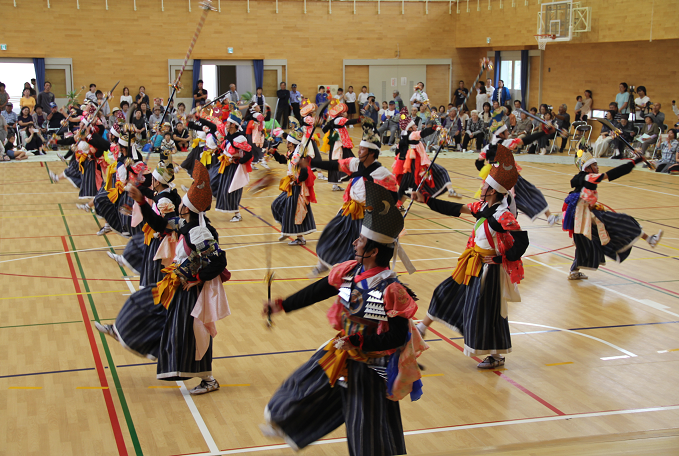中野七頭舞
なかのななつまい
Nakano Nanazumai
団体名 : 中野七頭舞保存会
所在地 : 岩手県岩泉町 小本
種別 : 踊り(三陸国際芸術祭過去出演団体)
三陸国際芸術祭出演 : 2019秋 岩泉/2021三陸×アジア「髪長姫 アジアが紡ぐ笛ものがたり」
中野七頭舞は、岩泉町中野地区に伝わる芸能で、発端は天保時代にさかのぼるといわれる。当時、神楽太夫と呼ばれた工藤喜太郎が、神楽舞の一部で(シットギジシ)という舞込みを基本に創始したといわれる。演舞する人数は、2人1組の7組で、「先打ち」「谷地払い」「ナギナタ」「太刀」「キネ」「小鳥」「ササラスリ」の7種類に分類される。舞の種類も「道具取り」「横跳ね」「チラシ」「戦い」「ツットウツ」「三足(鳥居掛かり)」「道具納め」の7つに分かれており、ここからも七頭舞の意味がうかがわれる。当初は神楽で踊られていたが、時代と共に変わり部落の祭典に奉納。五穀豊穰家内安全大漁を祈願して踊る中野七頭舞は、勇壮で活発な舞であり、舞う人達は、原野を開拓するため、汗を流しながら力いっぱい労働に励み、すばらしい田畑を作り、今年も豊作で皆さんと共に喜びをわかちあうという一連の流れを想いながら、力強くそしてしなやかに踊る。
The Nakano Nanazumai inherited in Nakano community in Iwaizumi town is said to be originated in the Tempo era (1831-1845). Kitaro Kudo, called as kagura tayu (a principal) at that time, is said to have developed this dance from a specific part of kagura dance called “Shittogijishi.” The dancers make seven pairs, each called as Sakiuchi, Yachiharai, Naginata, Tachi, Kine, Kotori and Sasarasuri. Their dance repertory is also divided into seven categories; Dogu-tori, Yokobane, Chirashi, Tatakai, Tsuttoutsu, Miashi (Toriigakari) and Dogu-osame, which partially explains the name of this dance. Although it had been danced as a part of kagura in the beginning, it has grown into a practice dedicated at community festivals over a long time. As a prayer for a good harvest and rich haul, they dance vigorously and briskly with energy and elasticity, recollecting a whole year of farmers; tillage, tough labor, rich fields, abundant crop and shared pleasure of harvest.
【Movie】
